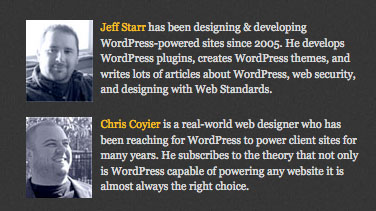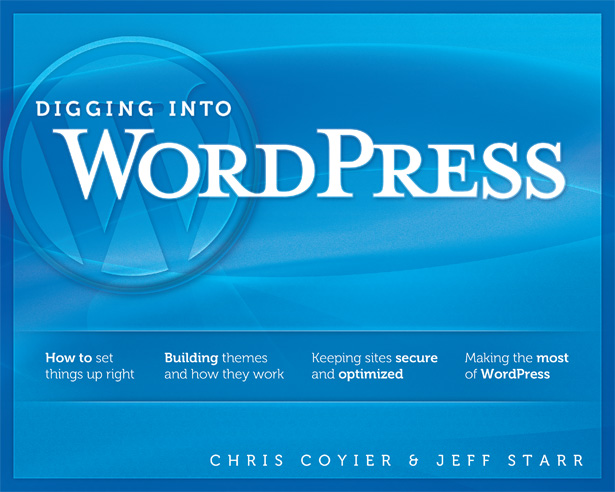 Digging Into WordPress by Chris Coyier and Jeff Starr is one of the most comprehensive looks at WordPress available.
Digging Into WordPress by Chris Coyier and Jeff Starr is one of the most comprehensive looks at WordPress available.
At over 400 pages long, it's massive, whether you have the PDF version or the print edition.
Whether you're just getting started with WP or you've been using it for years, there's something for everyone in this book.
In this post, we'll review the book and talk a bit about its highlights and features.
If you own this book or have read it, please feel free to add your own comments at the end of this post.
The overall tone of the book is conversational:
If you are buying this because your boss is making you design a site around WordPress and you are none too happy about it... Bummer. But hopefully by the end we can turn your frown upside down and bring you into the light.
 [/caption]
[/caption]
The design and layout of Digging Into WordPress is second to none.
If you appreciate good typography and a well-thought-out book design, this is worth purchasing just on those points.
The book is filled with useful sidebars that give more detail on important topics without interrupting the flow of the main text.
Despite its bulk, it's also a relatively quick read and is easily scannable to find just the parts that you're interested in.
Sidebars about things like the pros and cons of Short URLs (including a WP plugin that will allow you to create your own URL shortener rather than relying on an outside service) and a rundown of useful plugins for theme developers (which includes Theme Switcher and two others) also really stand out in Digging Into WordPress.
They not only add to the design of the book, but also provide great information in easy-to-digest bites.
The first couple of chapters will be repetitive to anyone already familiar with WordPress, though they're still worth a look if for nothing other than a review. For those completely new to WP, they're a great introduction.
One thing that really sets Digging Into WordPress apart from other books on the subject is that it advocates diving right into using WP once you have it set up.
We have the whole rest of this book to prod and poke at settings and alter code and nitpick details. But none of that has any context unless you get your feet wet a little bit and start getting a feel for how WordPress works and how easy it makes publishing content.
After the very basic information of the first two chapters, chapter three starts getting into more of the meat of how WP works. It covers, in detail, how WordPress works: the common files used; the Loop; the header, footer, search form, comments and sidebar; and theme functions.
Many designers may already be familiar with much of this, but it's still a good idea to review it so you're on the same page as the authors for the remainder of the book.
Chapter four is where things really start to get interesting for designers and developers. Theme design and development are covered in depth, with sections on customizing the Loop, child themes, custom displays for sidebar and menu items, and using multiple themes.
Plenty of code examples are used, making it easy to replicate the results in your own site. An advantage to the PDF version of the book is that you can copy and paste the code directly.
The next few chapters cover other aspects of customizing WP, with chapters on extensibility, RSS feeds, comments, search engine optimization, and maintenance.
Plugins are covered in depth, though the focus is placed more on finding the right ones and using them than developing your own.
There's a section covering using WP as a CMS, too, with information on page templates, custom taxonomies, custom fields, and dynamic menus.
The chapter on RSS feeds might be a bit surprising to many readers. It's incredibly comprehensive at nearly 50 pages long and brings up all sorts of things many readers and casual RSS users might not have ever considered.
It gives detailed information on the types of feeds WP has available, how to configure and format them (including how images are handled in feeds) and things like using FeedBurner to handle your feed. There's also a section on customizing your feeds with things like excluding certain categories or authors.
There are many situations in which the default WordPress feeds simply won't do. For example, you may have a category or group of categories that you would like to exclude or include in your main site feed. Fortunately, WordPress provides plenty of special feed parameters that enable you to carefully craft the perfect custom feed.
The comments chapter covers everything from optimizing and formatting your comments and comment form to controlling comment spam. From there it moves on to SEO, where it covers WP's strengths and weaknesses in this area, among other things.
The maintenance chapter is one everyone should read. It covers basics like security and errors as well as things like updates and optimization. General maintenance for plugins and the database are also covered.
The book closes with two particularly interesting chapters. First is the "Bonus Tricks" chapter, which includes creating and displaying author bios, creating a theme options panel (particularly useful if you want to create themes for distribution). Two free WP themes are also included, Lines & Boxes, and Plastique.
The final chapter covers new developments in WP 2.9. Considering the book will be updated continuously, this section is indicative of how future revisions will be handled. It covers everything from the new image editor to post thumbnails and new maintenance tools.
Digging Into WordPress isn't going to be much use to advanced WordPress users, who are likely already familiar with most of what is covered. There's limited information on creating your own custom plugins and functions, with more focus placed on using existing plugins.
The easiest way to integrate additional functionality into WordPress involves taking advantage of the thousands of plugins available at the WordPress Codex and around the Web.
Despite the few (relatively minor) shortcomings, the book is definitely one of the best resources out there for beginner to intermediate WP users.
It starts out simply enough that those completely new to WP should have no problem getting started, and covers enough more advanced material to keep those who have already started development with WP happy. If theming and customization is your primary interest, this is definitely the book for you.
Digging Into WordPress is available in print and PDF formats. The print version (which includes a download of the PDF) is spiral bound to make it easy to keep open on your desk while you work. It retails for $67. The PDF is a little less than half that at $27 (this review was based on the PDF version).
Reviewed exclusively for WDD by Cameron Chapman.
Have you read this book? What are your thoughts on it? Please share below...















